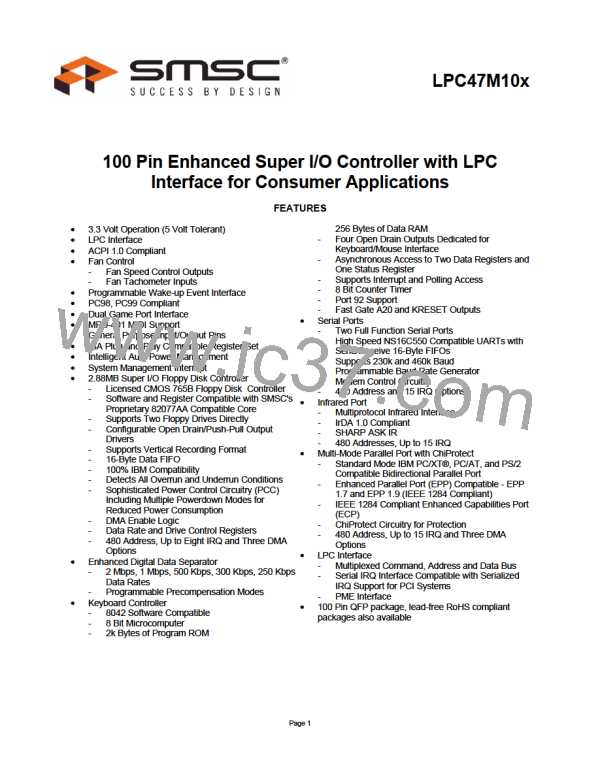1. If the EPP bus is not ready (nWAIT is active low) when nDATASTB or nADDRSTB goes active then the write can
complete when nWAIT goes inactive high.
2. If the EPP bus is ready (nWAIT is inactive high) then the chip must wait for it to go active low before changing the
state of nDATASTB, nWRITE or nADDRSTB. The write can complete once nWAIT is determined inactive.
Write Sequence of operation
1. The host initiates an I/O write cycle to the selected EPP register.
2. If WAIT is not asserted, the chip must wait until WAIT is asserted.
3. The chip places address or data on PData bus, clears PDIR, and asserts nWRITE.
4. Chip asserts nDATASTB or nADDRSTRB indicating that PData bus contains valid information, and the WRITE
signal is valid.
5. Peripheral deasserts nWAIT, indicating that any setup requirements have been satisfied and the chip may begin the
termination phase of the cycle.
6. a) The chip deasserts nDATASTB or nADDRSTRB, this marks the beginning of the termination phase. If it has
not already done so, the peripheral should latch the information byte now.
b) The chip latches the data from the internal data bus for the PData bus and drives the sync that indicates that no
more wait states are required followed by the TAR to complete the write cycle.
7. Peripheral asserts nWAIT, indicating to the host that any hold time requirements have been satisfied and
acknowledging the termination of the cycle.
8. Chip may modify nWRITE and nPDATA in preparation for the next cycle.
EPP 1.9 Read
The timing for a read operation (data) is shown in timing diagram EPP Read Data cycle. The chip inserts wait states into
the LPC I/O read cycle until it has been determined that the read cycle can complete. The read cycle can complete
under the following circumstances:
1
If the EPP bus is not ready (nWAIT is active low) when nDATASTB goes active then the read can complete when
nWAIT goes inactive high.
2. If the EPP bus is ready (nWAIT is inactive high) then the chip must wait for it to go active low before changing the
state of WRITE or before nDATASTB goes active. The read can complete once nWAIT is determined inactive.
Read Sequence of Operation
1. The host initiates an I/O read cycle to the selected EPP register.
2. If WAIT is not asserted, the chip must wait until WAIT is asserted.
3. The chip tri-states the PData bus and deasserts nWRITE.
4. Chip asserts nDATASTB or nADDRSTRB indicating that PData bus is tri-stated, PDIR is set and the nWRITE signal
is valid.
5. Peripheral drives PData bus valid.
6. Peripheral deasserts nWAIT, indicating that PData is valid and the chip may begin the termination phase of the
cycle.
7. a) The chip latches the data from the PData bus for the internal data bus and deasserts nDATASTB or
nADDRSTRB. This marks the beginning of the termination phase.
b) The chip drives the sync that indicates that no more wait states are required and drives the valid data onto the
LAD[3:0] signals, followed by the TAR to complete the read cycle.
8. Peripheral tri-states the PData bus and asserts nWAIT, indicating to the host that the PData bus is tri-stated.
9. Chip may modify nWRITE, PDIR and nPDATA in preparation for the next cycle.
EPP 1.7 OPERATION
When the EPP 1.7 mode is selected in the configuration register, the standard and bi-directional modes are also
available. If no EPP Read, Write or Address cycle is currently executing, then the PDx bus is in the standard or bi-
directional mode, and all output signals (STROBE, AUTOFD, INIT) are as set by the SPP Control Port and direction is
controlled by PCD of the Control port.
In EPP mode, the system timing is closely coupled to the EPP timing. For this reason, a watchdog timer is required to
prevent system lockup. The timer indicates if more than 10usec have elapsed from the start of the EPP cycle to the end
of the cycle. If a time-out occurs, the current EPP cycle is aborted and the time-out condition is indicated in Status bit 0.
Page 76

 SMSC [ SMSC CORPORATION ]
SMSC [ SMSC CORPORATION ]